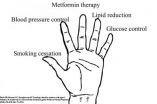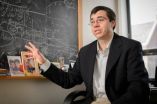(Press-News.org) Scottsdale, Ariz., February 20, 2014—Limiting radiation therapy to lymph nodes on one side of the neck for advanced tonsil cancer resulted in good local regional control and no cancer recurrence on the untreated side, according to research presented today at the 2014 Multidisciplinary Head and Neck Cancer Symposium. Additionally, the study results indicate that primary tumor location, rather than the amount of lymph node involvement on the tumor side of the neck, dictates the risk for disease in the opposite side of the neck.
The study focused on 46 out of 153 total patients with squamous cell carcinoma of the tonsil who received treatment between 1997 and 2012 at Washington University in St. Louis. Tumor location was well-documented in the 46 patients who received unilateral radiation therapy (RT), with 40 patients (87 percent) having lateralized (located on one side of the throat) primary tumors; two patients (4 percent) had non-lateralized tumors, and in four patients (9 percent), lateralization could not be determined retrospectively. The patients underwent surgical resection and postoperative intensity modulated radiation therapy (IMRT), with 30 patients also receiving concurrent chemotherapy.
Of the subset of 46 patients treated unilaterally, 72 percent were men, and the average patient age was 59. Sixty-one percent of patients were current or former smokers. The cancer stage/classification for the study group was: TX = 2 percent (1); T1 = 44 percent (20); T2 = 41 percent (19); and T3 = 13 percent (6). The patients' stages of lymph node involvement were: N0 = 11 percent (5); N1 = 13 percent (6); and N2 = 76 percent (35). The prescribed radiation doses were 60-66 Gy to the postoperative bed and involved neck; and 52-54 Gy to the elective neck in 30-33 fractions using a simultaneous integrated boost technique.
The median follow-up period was 2.8 years (range was .4 to 8.7 years). There were no local or regional recurrences reported, meaning the cancer did not recur in the adjacent nodes or the original location of the cancer in any of the patients. Distant metastasis, meaning the cancer spread from the original tumor site to distant organs or lymph nodes, developed in four (9 percent) of the patients. Two patients developed second primary (new) cancers.
"All treatments for cancer—surgery, radiation therapy, chemotherapy—although effective, can cause temporary and/or permanent toxicity which can affect long-term quality of life," said study author Wade Thorstad, MD, chief of Head and Neck Services and associate professor of Radiation Oncology at Washington University School of Medicine. "Our research indicates that for appropriately selected patients with tonsil cancer, the volume of radiation therapy necessary to control the cancer can be significantly reduced, therefore reducing the side effects and toxicity of radiation, while maintaining a high rate of tumor control."
INFORMATION:
The abstract, "Unilateral Radiotherapy in Node Positive Patients with Lateralized Tonsillar Carcinoma," will be presented in detail as a poster presentation at the 2014 Multidisciplinary Head and Neck Cancer Symposium. To speak with Dr. Thorstad, contact Michelle Kirkwood on February 20 – 21, 2014 in the ASTRO Press Office at the JW Marriott Camelback Inn Resort and Spa in Scottsdale, Arizona at 480-596-7085 or email michellek@astro.org.
The 2014 Multidisciplinary Head and Neck Cancer Symposium is sponsored by the American Society for Radiation Oncology (ASTRO), the American Society of Clinical Oncology (ASCO) and the American Head & Neck Society (AHNS). The two-and-a-half day meeting includes interactive educational sessions focused on topics such as supportive care, directed therapy, new surgical and radiotherapeutic techniques, as well as 12 oral abstract presentations of the current science of relevance to the head and neck cancer community. A total of 189 abstracts will be presented including 177 posters. Keynote speakers include Jennifer Grandis, MD, of the University of Pittsburgh, to present "The Molecular Road to Defining and Targeting High-risk Head and Neck Patients;" and Julia H. Rowland, PhD, of the National Cancer Institute, to present "Cancer Survivorship: Research Opportunities on the Path to Where We Want to Be."
Embargoed until 8:00 a.m. MT, February 20, 2014
2014 Multidisciplinary Head and Neck Cancer Symposium
News Briefing, Friday, February 21, 2014, 7:00 a.m. Mountain time
Poster Presentation: 154 Unilateral Radiotherapy in Node Positive Patients with Lateralized Tonsillar Carcinoma
Definitive Management of Head and Neck Squamous Cell Carcinoma
M. Y. Hwang, C. R. Spencer, P. Patel, R. Chin, H. A. Gay, B. H. Haughey, B. Nussenbaum, D. Adkins, J. S. Lewis, W. L. Thorstad, Washington University School of Medicine, St. Louis, MO
Background: Unilateral radiotherapy in lateralized tonsil carcinoma is considered safe for patients with low nodal stage (N0-N1) disease. There is a paucity of literature reporting unilateral radiotherapy for advanced (N2) nodal disease. Here we report the Washington University experience using unilateral radiotherapy for advanced nodal stage in lateralized tonsillar squamous cell carcinoma.
Methods and Materials: Between 1997 and 2012, 153 consecutive patients with squamous cell carcinoma of the tonsil were treated with surgical resection and postoperative IMRT. Lateralization was well documented in 129 patients (84%). 46 patients received unilateral radiotherapy. The N and T stage for this group was N0, N1, N2, or N3 disease in 5 (11%), 6 (13%), 35 (76%), and 0 (0%), respectively and the number with TX, T1, T2, T3, or T4 disease were 1 (2%), 20 (44%), 19 (41%), 6 (13%), and 0 (0%), respectively. Prescribed radiation doses were 60-66 Gy to the postoperative bed and involved neck and 52-54 Gy to the elective neck in 30-33 fractions using a simultaneous integrated boost technique. 30/46 patients received concurrent chemotherapy.
Results: Of the 46 patients treated unilaterally, 72% were men, median age was 59 years, 61% were known current or ex-smokers, and 33 patients (72%) were p16 immunohistochemistry positive. Forty patients (87%) had lateralized primary tumors, 2 patients (4%) had non-lateralized tumors, and in 4 patients (9%) lateralization could not be determined retrospectively. The median follow up period was 2.8 years (range, 0.4 - 8.7 years). There were no local or regional recurrences in this group of patients treated with unilateral radiotherapy. Distant metastasis developed in 4/46 (9%), and 2 patients developed second primaries.
Conclusions: In this cohort of patients with lateralized tonsil cancer, in whom 76% had N2 neck disease, no contralateral neck failures occurred with unilateral radiotherapy. These results support the contention that primary tumor location rather than ipsilateral neck N stage dictate the risk for disease in the contralateral neck.
Author Disclosure Block: M.Y. Hwang: None. C.R. Spencer: None. P. Patel: None. R. Chin: None. H.A. Gay: None. B.H. Haughey: None. B. Nussenbaum: None. D. Adkins: None. J.S. Lewis: None. W.L. Thorstad: None.
Unilateral radiation therapy for advanced stage tonsil cancer results in favorable outcomes
2014-02-20
ELSE PRESS RELEASES FROM THIS DATE:
MATH, HPV status in HNSCC patients effective markers of improved patient outcome
2014-02-20
Scottsdale, Ariz., February 20, 2014—Evaluating next-generation sequencing (NGS) data and associated clinical records of head and neck squamous cell carcinoma (HNSCC) patients from several institutions, made available through The Cancer Genome Atlas (TCGA), showed that combining Mutant-Allele Tumor Heterogeneity (MATH) as a biomarker with the patient's HPV status provides an effective indicator of improved patient outcome, according to research presented today at the 2014 Multidisciplinary Head and Neck Cancer Symposium.
The TCGA data available for HNSCC patients included ...
Rural primary care physicians are committed to professionalism, quality improvement
2014-02-20
The increased demand for primary care services expected to result from the Affordable Care Act (ACA) may be felt strongly in rural areas. While studies have found that the quality of care delivered to rural patients is as good or better than that available in urban areas, the belief persists that top-quality primary care is only available in big cities. But a new study appearing in the National Rural Health Association's Journal of Rural Health finds few meaningful differences between rural and urban primary care physicians on key measures of professionalism, including ...
Study examines correctional officer stress
2014-02-20
HUNTSVILLE, TX (2/20/14) -- Conflicts between work and family life were the most significant issues that affect work stress and job satisfaction among correctional officers, a new study by the Correctional Management Institute of Texas at Sam Houston State University found.
In a study of 441 correctional officers from adult prisons in the South, the most significant work-home issues experienced by correctional officers were demands and tensions from work that impact their home life; an incompatibility between the officer's role at work and at home; and family circumstances ...
Meet your match: Using algorithms to spark collaboration between scientists
2014-02-20
Speed dating, in which potential lovers size each other up in brief 10 minute encounters before moving on to the next person, can be an awkward and time-wasting affair. Finding the perfect research partnership is often just as tough. Speed dating-style techniques are increasingly used at academics conferences, but can be equally frustrating - with busy academics being pushed into too many pointless encounters.
But now a group of scientists led by geneticist Rafael Carazo Salas have constructed a system that could revolutionise conference speed dating - by treating scientists ...
Editorial illustrates shift away from glycemic control in diabetes treatment
2014-02-20
BOSTON (February 20, 2014)—An editorial in a February issue of American Family Physician proposes a simple way for physicians to communicate with patients about the best treatments for diabetes. The "lending a hand" illustration reprioritizes treatment goals, based on research on mortality reduction, to convey that glycemic control is no longer the primary intervention.
In order of benefit, to improve length and quality of life, patients with type 2 diabetes benefit from these interventions, starting with smoking cessation:
"Glycemic control is stuck in people's minds ...
Why are some children more resilient to post-traumatic stress?
2014-02-20
New Rochelle, NY, February 20, 2014—Children exhibit a range of responses to traumatic events such as natural disasters, with some suffering acute traumatic reactions that resolve over time and others experiencing long-term symptoms of post-traumatic stress. Identifying factors that may help predict which youths are at greater risk of more serious disorders and which are likely to be more resilient following a traumatic event can help determine the care and services needed, according to an article in Journal of Child and Adolescent Psychopharmacology (JCAP), a peer-reviewed ...
What is El Nino Taimasa?
2014-02-20
During very strong El Niño events, sea level drops abruptly in the tropical western Pacific and tides remain below normal for up to a year in the South Pacific, especially around Samoa. The Samoans call the wet stench of coral die-offs arising from the low sea levels "taimasa" (pronounced [kai' ma'sa]). Studying the climate effects of this particular variation of El Niño and how it may change in the future is a team of scientists at the International Pacific Research Center, University of Hawai'i at Mānoa and at the University of New South Wales, Australia.
Two El ...
Remote Antarctic telescope reveals gas cloud where stars are born
2014-02-20
Using a telescope installed at the driest place on earth - Ridge A in Antarctica – a UNSW-led team of researchers has identified a giant gas cloud which appears to be in an early stage of formation.
Giant clouds of molecular gas – the most massive objects in our galaxy – are the birthplaces of stars.
"This newly discovered gas cloud is shaped like a very long filament, about 200 light years in extent and ten light years across, with a mass about 50,000 times that of our sun," says team leader, Professor Michael Burton, an astronomer at UNSW Australia.
"The evidence suggests ...
With friends like these, who needs democracy?
2014-02-20
EAST LANSING, Mich. — From Ethiopia to Nicaragua, countries that go through civil war are much less likely to become democratic if the winning side gets help from rival nations, a Michigan State University political scientist argues.
In a new study examining democratization after civil wars since World War II, Michael Colaresi found the majority of groups that eventually took power failed to establish democratic governments if those groups took money or weapons from a foreign enemy during the war.
Receiving such aid can create mistrust among the nation's citizens and ...
Sustainable use of energy wood resources shows potential in North-West Russia
2014-02-20
Nowadays, humanity faces many challenges; the most serious are poverty, the growing demand for resources and the deterioration of the environment. In order to satisfy the growing demand for wood, forestry in many countries has to be intensified. The forests of the Russian Federation are the world's largest reserve of wood for different purposes. Intensification of forestry in Russia will result in increasing availability of wood for material and energy uses.
A doctoral dissertation completed at the University of Eastern Finland analysed the potential of energy wood resources ...




